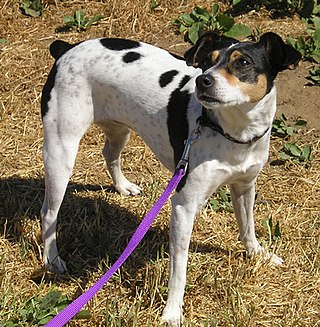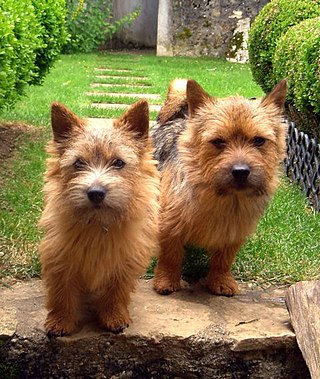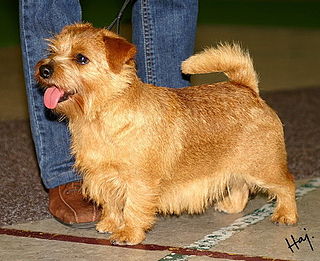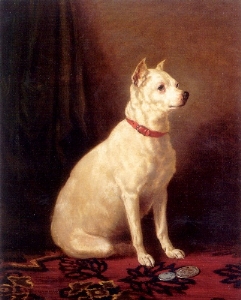Related Research Articles

The Basenji is a breed of hunting dog. It was bred from stock that originated in central Africa. The Fédération Cynologique Internationale places the breed in the Spitz and primitive types. The Basenji produces an unusual yodel-like sound, due to its unusually shaped larynx. This trait also gives the Basenji the nickname the 'barkless dog.'

The Scottish Deerhound, or simply the Deerhound, is a Scottish breed of large sighthound, once bred to hunt the red deer by coursing. In outward appearance it is similar to the Greyhound, but larger and more heavily boned, with a rough coat.

The whippet is a British breed of medium-sized dog, of the sighthound type, related to the larger greyhound and the smaller Italian greyhound. Apart from the differences in height, the whippet closely resembles these two breeds; it has sometimes been described as "the poor man's greyhound". It is kept as a companion dog, for competitive showing, for amateur racing as well as lure coursing. It has the highest running-speed of any breed in its weight and size range, and may have the fastest idle-to-running acceleration of any dog.

The Patterdale Terrier is a breed "type" of dog descended from the Northern terrier breeds of the early 18th century. Bred in Patterdale, Lake District.

The Australian Terrier is a small breed of dog of the terrier type. The breed was developed in Australia, although the ancestral types of dogs from which the breed descends were from Great Britain.

Collies form a distinctive type of herding dogs, including many related landraces and standardized breeds. The type originated in Scotland and Northern England. Collies are medium-sized, fairly lightly-built dogs, with pointed snouts. Many types have a distinctive white color over the shoulders. Collies are very active and agile, and most types of collies have a very strong herding instinct. Collie breeds have spread through many parts of the world, and have diversified into many varieties, sometimes mixed with other dog types.

The Rat Terrier is an American dog breed with a background as a farm dog and hunting companion. They share much ancestry with the small hunting dogs known as feists. Common throughout family farms in the 1920s and 1930s, they are now recognized by the United (UKC) and American Kennel Clubs (AKC) and are considered a rare breed. Rat Terriers are an intelligent and active breed that can be kept both for pest control and as a family pet.

The Norwich Terrier is a breed of dog originating in England, and was bred to hunt small rodents. One of the smallest terriers, these dogs are relatively rare. Their drop-eared variety is the Norfolk Terrier.

The Miniature Pinscher, also known as the Zwergpinscher and Mini Pin, is a small breed of dog of the pinscher type originating in Germany. While the breed's visual similarities to the Toy Manchester Terrier, which somewhat resembles the Pinscher breeds, remain a matter of controversy, genetic research has shown that the two breeds have shared, unique ancestry. The ancestors of the Toy Manchester and Miniature Pinscher may have become geographically separated many centuries ago and retained similarities simply through breeding selection for the same traits; nevertheless, the 2017 research also showed that the two breeds remain more closely related to each other than to other breeds. The breed's ancestors may also include the German Pinscher, Italian greyhounds and dachshunds. The Miniature Pinscher's known origins are in Germany, where it was often referred to as the Zwerg Pinscher in historical documents. German Kennel Club documents also refer to the Miniature Pinscher as the "reh" Pinscher, but this term is only used for a dog of stag-red color, "reh" referring to a small red deer formerly found in German forests. The Miniature Pinscher originated several centuries ago as an efficient barnyard ratter.
Canine terminology in this article refers only to dog terminology, specialized terms describing the characteristics of various external parts of the domestic dog, as well as terms for structure, movement, and temperament. This terminology is not typically used for any of the wild species or subspecies of wild wolves, foxes, coyotes, dholes, jackals or the basal caninae. Dog terminology is often specific to each breed or type of dog. Breed standards use this terminology in the description of the ideal external appearance of each breed, although similar characteristics may be described with different terms in different breeds.

The Norfolk Terrier is a British breed of dog. Prior to gaining recognition as an independent breed in 1964, it was a variety of the Norwich Terrier, distinguished from the "prick eared" Norwich by its "drop ears". Together, the Norfolk and Norwich Terriers are the smallest of the working terriers.

The Africanis is a dog landrace found across southern Africa. It is a medium-sized, short-coated dog, with a distinctive black patch on the outside of the tail.
Follicular dysplasia is a genetic disease of dogs causing alopecia, also called hair loss. It is caused by hair follicles that are misfunctioning due to structural abnormality. There are several types, some affecting only certain breeds. Diagnosis is achieved through a biopsy, and treatment is rarely successful. Certain breeds, such as the Mexican Hairless Dog and Chinese Crested Dog, are bred specifically for alopecia.

A feist is a small hunting dog, descended from the terriers brought over to the United States by British miners and other immigrants. These terriers probably included crosses between the Smooth Fox Terrier, the Manchester Terrier, and the now-extinct English White Terrier. These dogs were used as ratters, and gambling on their prowess in killing rats was a favorite hobby of their owners. Some of these dogs have been crossed with Greyhounds, Whippets or Italian Greyhounds, and Beagles or other hounds —extending the family to include a larger variety of purpose than the original ratter, or Rat Terrier.

The Skye Terrier is a Scottish dog breed that is a long, low, hardy terrier and "one of the most endangered native dog breeds in the United Kingdom" according to The Kennel Club.

The English White Terrier is an extinct breed of dog. "English White Terrier" is the failed show ring name of a pricked-ear form of the white fox-working terriers that have existed in Great Britain since the late 18th century.

The Telomian is a type of dog found in isolated villages near the Telom River in the rainforests of the Malay Peninsula. It has been introduced into the United States. Some US-based breeders were selling these dogs as pure breds, which was dismissed with the Malaysian Kennel Association in a statement that these are pariah dogs and not a breed.

The Griffon Fauve de Bretagne is a breed of dog of the scenthound type, originating in France in the region of Brittany.

The Indian pariah dog, also known as the Indian native dog, INDog, Nadan,South Asian pye dog, Desi Kutta, and Neri Kutta, is a landrace of dog native to the Indian subcontinent. They have erect ears, a wedge-shaped head, and a curved tail. It is easily trainable and often used as a guard dog and police dog. This dog is an example of an ancient group of dog known as pye-dogs. There is archaeological evidence that the dog was present in Indian villages as early as 4,500 years ago.

Tesem was the ancient Egyptian name for "hunting dog". In popular literature it denotes the prick-eared, leggy dog with a curled tail from the early Egyptian age, but it was also used with reference to the lop-eared "Saluki/Sloughi" type. It was one of several types of dogs in Ancient Egypt; particularly the latter Saluki/Sloughi type of Tesem, having the appearance most similar to that of a true sighthound.
References
- ↑ "African Village Dogs Are Genetically Much More Diverse Than Modern Breeds". ScienceDaily. 6 August 2009. Retrieved 6 May 2013.
- ↑ Simpson, Professor MA (8 January 2013). "Dogs do come from Africa". health24. 24.com. Retrieved 13 May 2013.
- ↑ Wendorf, Fred (2001). Holocene settlement of the Egyptian Sahara. Volume 1, The archaeology of Nabta Playa. Romuald Schild. New York. ISBN 978-1-4615-0653-9. OCLC 885402023.
{{cite book}}: CS1 maint: location missing publisher (link) - ↑ Clutton, Juliet; Driscoll, Carlos A. (2016). "1-Origins of the dog:The archaeological evidence". In James Serpell (ed.). The Domestic Dog: Its Evolution, Behavior and Interactions with People (2 ed.). Cambridge University Press. p. 17. ISBN 978-1-107-02414-4.
- ↑ Boyko, Adam; Boykob, Ryan H.; Boykob, Corin M.; Parkerc, Heidi G.; Castelhanod, Marta; Corey, L.; Degenhardt, J. D.; Auton, A.; Hedimbi, M.; Kityo, R.; Ostrander, E. A.; Schoenebeck, J.; Todhunter, R. J.; Jones, P.; Bustamante, C. D. (2009-08-18). "Complex population structure in African village dogs and its implications for inferring dog domestication history". PNAS. 106 (33): 13903–13908. Bibcode:2009PNAS..10613903B. doi: 10.1073/pnas.0902129106 . PMC 2728993 . PMID 19666600.
- ↑ Avuvis. West African Dogs, Blogspot.com. Searched Feb 25th, 2019.
- 1 2 3 4 5 6 7 8 9 10 11 12 13 14 15 16 17 18 Morris, Desmond (2002). Dogs : the ultimate dictionary of over 1,000 dog breeds. North Pomfret, Vt.: Trafalgar Square Pub. ISBN 1-57076-219-8. OCLC 49515650.
- ↑ Kärmer, Eva-Maria. Der grosse Kosmos Hundeführer, p. 114. Kosmos, Stuttgart: 2009.
- ↑ Lane, Charles Henry (1900). All About Dogs: A Book For Doggy People. Kessinger Publishing, LLC. ISBN 978-1165937967.